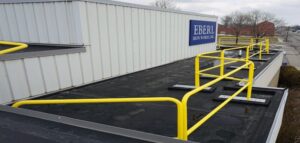Fall Protection Guardrail
Whether it’s a flat roof, walkway or stairwell, there are many fall hazards present on a construction job site. To keep workers safe, OSHA has a variety of rules in place to help stop falls at the source. One of the most effective solutions is to use guardrails. Designed specifically to stop falling over leading edges, skylights and roof hatches, these rails are made from strong materials like high-tensile aluminum that can handle the weight of a worker who falls through them. They are often used in combination with personal fall arrest systems to prevent workers from falling over the edge of a hazard and onto other areas below them.
If a work area does not have walls or other structures to provide support, fall protection guardrail must be installed. In some cases, a guardrail may not be needed for an entire work surface, but it’s important to check with local regulations to ensure that the appropriate protection is in place. For example, some jurisdictions require the installation of a toe board on open-sided platforms to keep workers from falling into or onto conveyor belts and other equipment below them.
The height of a guardrail system is also important. In general, the top edge of the guardrail must be between 39 and 45 inches above the walking/working surface, but it may exceed this height when conditions warrant (such as where employees are working at stilts). In these situations, mid rails or other intermediate vertical members must be installed between the top edge and the walking/working surface. This helps protect workers who may not be able to reach the upper level of the guardrail with their hands.

Installing a Fall Protection Guardrail
When installing a guardrail, employers must also consider the location of the work area and the type of work being done to determine the best configuration. The red zone, which is the first 6 feet closest to the leading edge of a walkway or platform, is usually considered the most dangerous and should be protected with guardrails or lifelines. The orange zone, which is the next 6 to 15 feet from the leading edge, is less dangerous and still requires safety equipment like guardrails or anchor points to prevent workers from falling through an unprotected opening.
In addition to being designed for maximum strength, guardrails must meet a variety of other requirements to ensure that they are capable of preventing falls. For example, the top rail must be able to withstand a force of 200 pounds directed downward or outward within two inches of any point along the top edge. Likewise, mid rails and other intermediate members must be able to withstand the same force within 2 inches of any point along their height.
If you’re looking for an easy-to-install, portable solution to prevent workplace falls, look no further than the HySafe freestanding guardrail. Manufactured from galvanized steel and powder coated, it is corrosion resistant for long-lasting use. Plus, the base attaches to the ground with two lag bolts for maximum stability and the rail segments are lightweight to reduce the load on your roof. For even greater flexibility, this system includes a removable toeboard and can be assembled in minutes. Available in a wide range of section lengths and kit sizes, this guardrail system will help you comply with OSHA standards while keeping your workers safe.